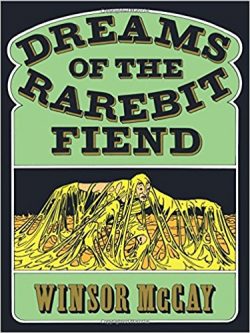
By Winsor McCay (Dover)
ISBN-13: 978-0-48621-347-7
Born in Spring Lake, Michigan, on 26th September, 1869 (or perhaps 1871- records differ) Winsor McCay was a brilliant and hugely successful cartoonist and animator who worked on strips and political cartoons from 1903 until his untimely death in 1934.
The first of these was Jungle Imps (1903), for The Enquirer, after which the dashing dauber moved to New York and created Dull Care, Poor Jake, The Man from Montclair, The Faithful Employee, Mr. Bosh, A Pilgrim’s Progress, Midsummer Daydreams and It’s Nice to be Married for New York Herald publisher James Gordon Bennett between1903 and 1911.
He also originated Little Sammy Sneeze for the Herald in 1904 and Hungry Henrietta in 1905 before abandoning both for two much more important features.
On October 15th 1905 the most important children’s strip in the world debuted in the Sunday Herald – Little Nemo in Slumberland.
Even before that momentous moment the tireless McCay had conjured up a version for adult readers of The Evening Telegram, entitled Dreams of the Rarebit Fiend. The editor, wishing to distance the feature from other strips, required McCay to use a pen-name, and he complied, signing the strips “Silasâ€, reputedly after a local garbage cart driver.
Where Nemo was a beautifully clean and surreal fantasy of childish imagination, Fiend was aimed at grown-ups and displayed a creepy, subdued tension that resonated with the fears and worries of its audience. Black, cruel and often outright sick humour pervades the series combining monstrous destruction and expressionist trauma. Even the root cause of the otherworldly nightmares was salutary. Each self-contained episode, every disturbing sequence of unsettling or terrifying, incredibly realistic images was the result of overindulgence; usually in late night toasted cheese treats!
Every anxiety from surreal terror to social embarrassment became grist for the fantasist’s mill and the startling perspectives, bizarre transformations and uncanny scenes – always immaculately rendered – made Fiend a hugely successful and well-regarded strip in its day.
In 1906 the American film pioneer Edwin S. Porter created a landmark 7-minute live action special-effects movie entitled The Dream of a Rarebit Fiend and the Edison company created a cylinder recording with the same name the following year – played by the Edison Military Band.
McCay himself produced four animated films in 1916-17: Dream of a Rarebit Fiend; Dreams of the Rarebit Fiend: The Pet, Dreams of the Rarebit Fiend: The Flying House and Dreams of the Rarebit Fiend: Bug Vaudeville.
Despite his other later successes McCay also returned to the feature sporadically over the years: between 1923 to 1925 he revived the strip under the title Rarebit Reveries and attributed the strip to his son who signed the panels Robert Winsor McCay, Jr.
This slim sleek monochrome book is an almost exact reproduction of Rarebit Fiend, a vintage collection of the first year’s strips originally released by the Frederick A. Stokes Company in 1905. The very last strip has been excluded from this edition however, due to its content being regarded as potentially offensive and at odds with modern views on race and ethnicity.
Although working more than a century ago Winsor McCay still affects every aspect of graphic narrative produced ever since. If you can’t locate or afford Ulrich Merkl’s superb complete edition, reprinting everything from 1905-1914, this lovely package – still readily and economically available from internet retailers and packaged as an oversized paperback album or eBook – is a superb introduction to the darker side of an absolute master of our art form.
© 1973 by Dover Publications, Inc. All rights reserved.
